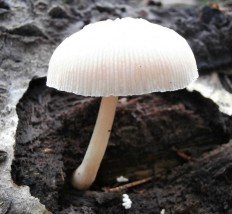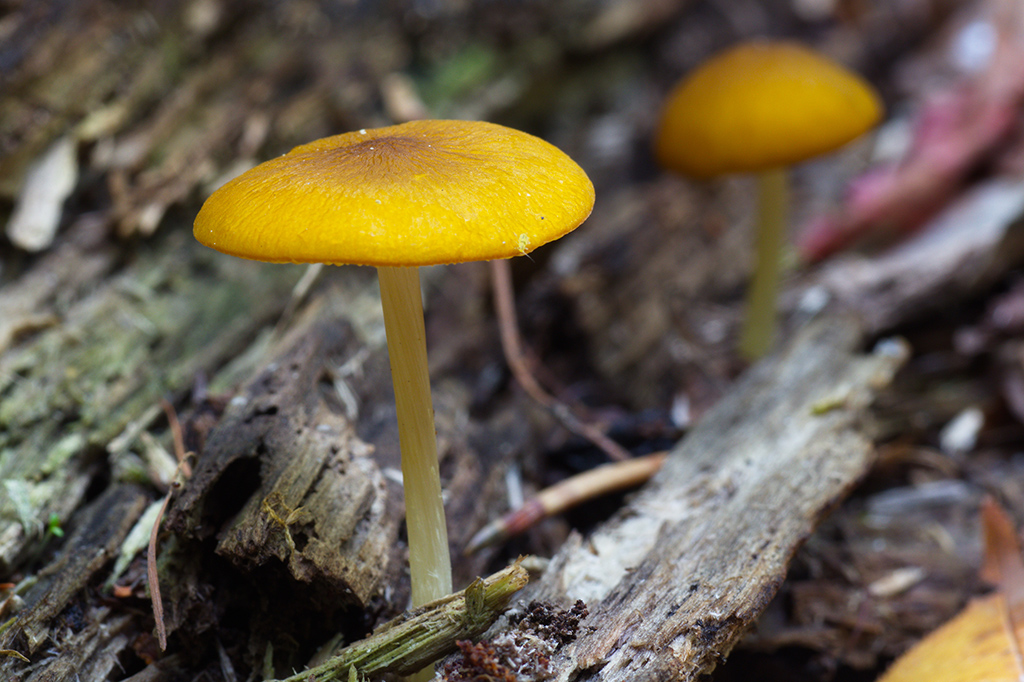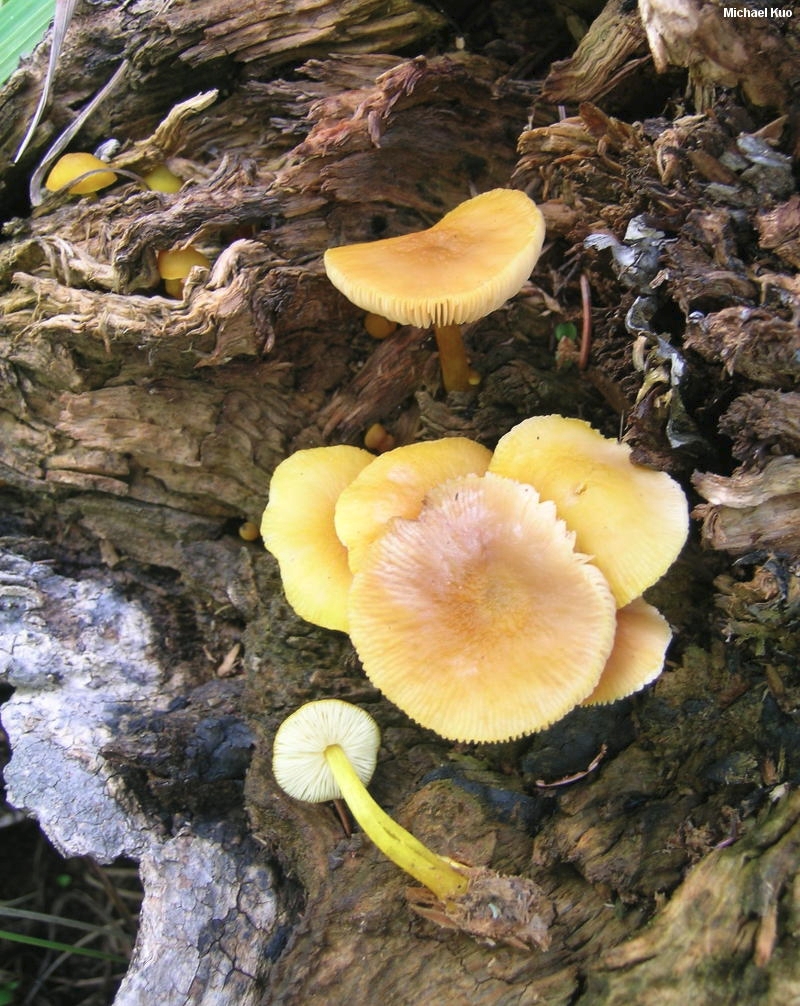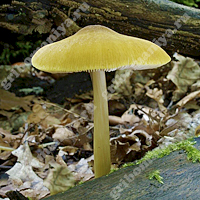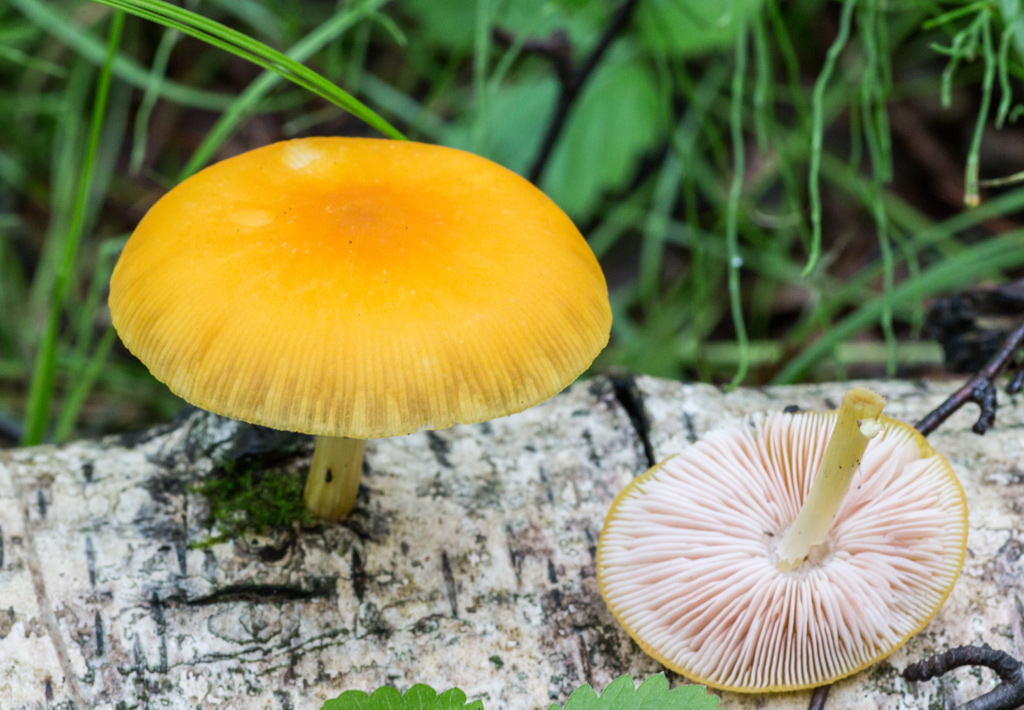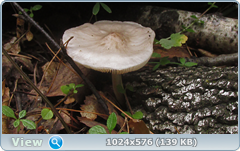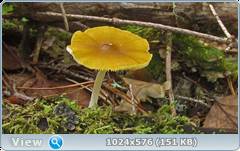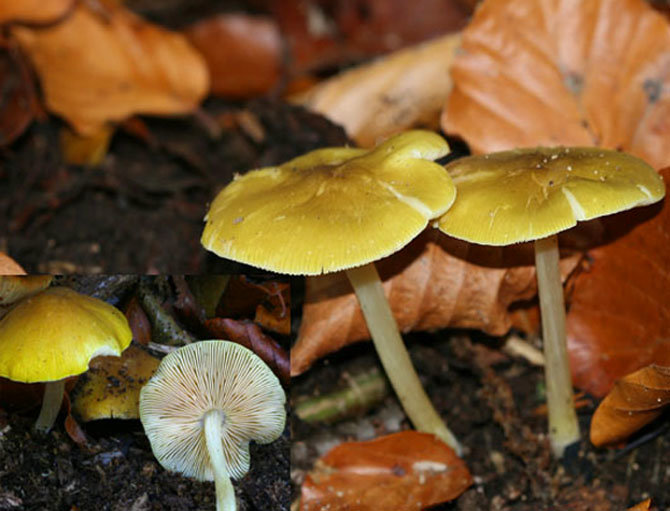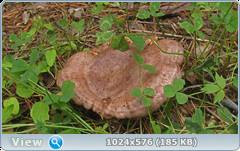Definitioner
- Basidia (Basidia)
-
Lat. Basidia. A specialized structure of sexual reproduction in fungi, inherent only in Basidiomycetes. Basidia are terminal (end) elements of hyphae of various shapes and sizes, on which spores develop exogenously (outside).
Basidia are diverse in structure and method of attachment to hyphae.
According to the position relative to the axis of the hypha, to which they are attached, three types of basidia are distinguished:
Apical basidia are formed from the terminal cell of the hypha and are located parallel to its axis.
Pleurobasidia are formed from lateral processes and are located perpendicular to the axis of the hypha, which continues to grow and can form new processes with basidia.
Subasidia are formed from a lateral process, turned perpendicular to the axis of the hypha, which, after the formation of one basidium, stops its growth.
Based on morphology:
Holobasidia - unicellular basidia, not divided by septa (see Fig. A, D.).
Phragmobasidia are divided by transverse or vertical septa, usually into four cells (see Fig. B, C).
By type of development:
Heterobasidia consists of two parts - hypobasidia and epibasidia developing from it, with or without partitions (see Fig. C, B) (see Fig. D).
Homobasidia is not divided into hypo- and epibasidia and in all cases is considered holobasidia (Fig. A).
Basidia is the place of karyogamy, meiosis and the formation of basidiospores. Homobasidia, as a rule, is not functionally divided, and meiosis follows karyogamy in it. However, basidia can be divided into probasidia - the site of karyogamy and metabasidia - the site of meiosis. Probasidium is often a dormant spore, for example in rust fungi. In such cases, probazidia grows with metabasidia, in which meiosis occurs and on which basidiospores are formed (see Fig. E).

See Karyogamy, Meiosis, Gifa.
- Pileipellis
-
Lat. Pileipellis, skin - differentiated surface layer of the cap of agaricoid basidiomycetes. The structure of the skin in most cases differs from the inner flesh of the cap and may have a different structure. The structural features of pileipellis are often used as diagnostic features in descriptions of fungi species.
According to their structure, they are divided into four main types: cutis, trichoderma, hymeniderma and epithelium.
See Agaricoid fungi, Basidiomycete, Cutis, Trichoderma, Gimeniderm, Epithelium.
- Pileipellis (Pileipellis)
-
Lat. Pileipellis, skin - differentiated surface layer of the cap of agaricoid basidiomycetes. The structure of the skin in most cases differs from the inner flesh of the cap and may have a different structure. The structural features of pileipellis are often used as diagnostic features in descriptions of fungi species.
According to their structure, they are divided into four main types: cutis, trichoderma, hymeniderma and epithelium.
See Agaricoid fungi, Basidiomycete, Cutis, Trichoderma, Gimeniderm, Epithelium.
- Ixokutis
-
Cutis, consisting of hyphae immersed in mucus. The surface of the cap is oily, slippery or slimy.
Lat. Ixocutis.
See Cutis, Gifa.
- Cutis
-
The type of cap skin, consists of creeping non-gelatinized hyphae located parallel to the surface. The surface of the cap looks smooth.
Lat. Cutis.
See Gifa.
Similar types and differences from them
Even a novice mushroom picker can easily distinguish a willow spit from other spits. The main difference is the spots on the leg of a blue or green hue. However, this trait is highly dependent on the area where the fungus grows.
The hero of the article can be confused with small representatives of the species "reindeer whips" (in Latin - Pluteus cervinus), from which it will differ in the color of the pulp after the cut (in the deer, the cut does not change color). Also, a microscope will help to distinguish these two species from each other: the deer spit does not have the buckles on the mycelium, which the willow has.
Based on the foregoing, it is possible to eat willow sticks for food, but this must be done carefully and carefully.
Pay attention to where you collected it. Maybe not worth the risk and taste it
Distribution and fruiting period
Reindeer wicker is a saprophyte, and therefore it grows on dead and decaying wood of both deciduous and various conifers, including, for example, birch, oak, pine. He respects not only tree trunks, but also old rotten and rotten stumps, branches, wood chips, sawdust, bark, dead wood. It comes across in deciduous forests, sometimes does not disdain conifers, it is found in gardens and parks, in clearings. In some cases, sticks can also be found on the ground, provided that there is a rotting stump nearby.
Growing regions - almost all of Europe, as well as in Russia. The fruiting period is from late spring to early autumn. It grows well even in drought conditions.
Distribution and fruiting period
The main distribution area of the noble spit is North America and Eurasia, from the temperate northern to the Far Eastern natural zones. In Russia, the mushroom can be found on the territory of the Leningrad, Rostov regions and the Krasnodar Territory, in the Volga region, Eastern Siberia and Primorye. Being saprotrophic mushrooms, noble spitters choose the remains of deciduous wood as a substrate - stumps of poplars, oaks, beeches, preferring moist shady areas of the soil. You can see them under living trees of these species in the lowland and alpine forests.

Mushrooms grow both as individual specimens and in small families. They appear at the end of May and bear fruit until mid-autumn. Fruiting takes place in two waves: in the lowland zones in June, in the highlands in July-August, then in September-October.
White clue: photo and description
See what the rogue looks like in the photo:
In the photo, White Plyutey
More recently, research by biologists has shown that some subspecies have a small dose of the glucinogenic component. Therefore, the use of such mushrooms for cooking is highly questionable.
There are several subspecies:
- deer;
- White;
- scaly;
- noble;
- willow.
The mushroom can be used for food. Another name is lashes of kuchkovaty. You can meet him in Europe, Japan, China, Primorye and Siberia. Some specimens have been found in the states of the northern part of the African continent.
Main external characteristics:
- The lower part is up to 12 cm long, its thickness is within 1-2 cm. It is filled with pulp with fibers, white. The leg is smooth and firm. Volvo and ring are undetectable.
- The upper part is up to 12 cm in diameter, fragile, finely fleshy. On a young mushroom, the cap resembles a half of a sphere, then it opens up, a low blunt tubercle forms. It is fibrous, silky, white, sometimes with scales closer to the center.
- The plates are high, loose, white or slightly pinkish. But this shade appears in old mushrooms. The young have white plates.
- The pulp is white, soft. On the cut, it does not change color, without a pronounced odor. Near the cap, its color becomes close to yellow.
The mushroom itself does not have a distinct smell or taste.
Grows in gardens, forest plantations and vegetable gardens. Appears from May to November. On wood residues, on the lawn in places where there was mulching with sawdust, it often grows in mulched beds.
There are no poisonous mushrooms similar to rods without a ring and without a Volvo. But some mushroom pickers talk about similarities with a subspecies from the same Pluteyev family - orange-powerful.
It requires boiling for 15 minutes, which makes the mushroom suitable for further use. White stick can be used in second courses and for pickling.
It is not used in medical practice.
False doubles
Most of them belong to rather safe and low-toxic mushrooms. The most similar species and the level of their edibility are shown in the table.
| Mushroom name | Edibility | Features of the mushroom |
Black-sided Plutey |
Edible but little known | Unlike its counterpart, the edges of the plates under the cap have a dark, burgundy or brown edging. The fungus is less common, mainly in coniferous forests. It has a faint pleasant smell and a white or yellowish flesh that does not change color when cut. |
Pouzar's clown |
Edible unknown | Differs in the structure of the colored cap skin. It is more fibrous and begins to flake off over time. The plates also differ, but not in color, but in structure: between the long plates there are shorter ones, usually at the very edge of the cap. |
Volvariella (a genus of mushrooms of the same family) |
Mostly edible | A number of representatives of the genus Volvariella are extremely similar to the deer mushroom. Mushrooms are considered edible and are even cultivated in some countries. They are distinguished by the presence of a blanket, a small sac in which the fruiting body is in the early stages of growth. Over time, it breaks, leaving a semblance of a calyx at the base of the mushroom. |
Entoloma (a genus of fungi of the Entolomaceae family) |
Low edible, most species are toxic | Fungi of this genus are poorly studied and rare, but most of the samples found contain toxins that cause severe food poisoning. It is easy to distinguish them from spitters by the characteristic accretion of plates to the stem of the fungus (whereas in the spit of a deer plate, the plates are "free"). The place of growth is also different. Entholomaceae prefer to grow in soil rather than on dead wood. |
Colibia wide-lamellar |
Inedible | The plates of the fungus are located much less frequently, they are yellowish, not pink. As with entol, the plates grow a little to the stem. At the base of the mushroom there is a clearly visible constriction (like a step), sometimes framed by a short white skirt. The leg itself narrows towards the base, while in the spit it, on the contrary, expands. |
Growing a mushroom mushroom at home
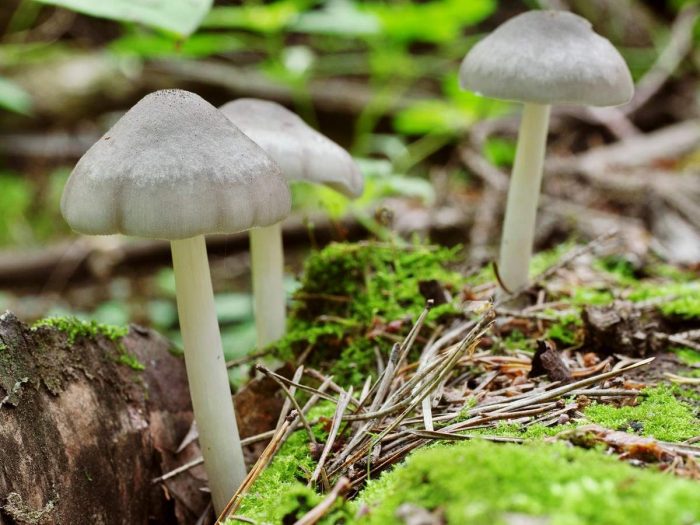
To grow the spit, a homogeneous or combined substrate of two or more constituents is prepared in any proportions (for example, just straw, or straw with sawdust and hay), it is placed in a container and poured with boiling water. The steamed substrate is allowed to cool down to 20-30 ° C. Then it is squeezed well and thoroughly mixed with mycelium (1 pack for 15 kg of moistened substrate). The resulting mixture is placed in a transparent plastic bag, lightly crushed and tied. To ensure air exchange, incisions are made about the entire area of the package (3-5 cm).
The mushroom block obtained in this way is left indoors or in a shady place in the garden. During the first month of germination, he does not need lighting. First, fluff appears, then the substrate becomes white or yellowish and turns into a dense block. After 1.5-2 weeks, the rudiments of fruiting bodies appear and the block is placed in the light, and film cuts are made in the places of the rudiments. Fruiting occurs in waves, every 2-3 weeks. The largest harvest comes from the first 2 waves.
Also, cakes are grown on deciduous non-rotten wood.
To do this, pick up bars and logs 30-40 cm long and 25 cm in diameter. They are soaked in water for a week. Next, holes are drilled or sawed into them, into which the mycelium is placed (1 package per 15 kg), and from above they are sealed with a watering can with tape or laid with straw. The mycelium grows from 3 to 6 months at a temperature of 7-27 ° C. At this time, the bars are placed in shady places in the garden or in ventilated areas. The crop is harvested 1-2 times in the spring and 1-2 times in the fall.
Practical value
The genus contains edible species; mushroom pickers are best known for deer roaches (Pluteus cervinus(Pluteus umbrosus), dark-edge rogue (Pluteus atromarginatus). Inedible species include such species as velvety-footed sticks (Pluteus plautus), noble rogue (Pluteus plautus). Some common species in the special literature are characterized as "little-known edible mushrooms", but some authors classify them as inedible - dwarf cod (Pluteus nanus), venous crimson (Pluteus phlebophorus). In many species, nutritional or toxic properties have not been studied and are considered inedible.
For several species, the possibility of medicinal use is being studied. In experiments on mice, it was found that the extract of polysaccharides from deer spit suppresses the growth of malignant tumors, anti-cancer and immunostimulating effects were found in dwarf spit, lion-yellow (Pluteus leoninus), orange-wrinkled (Pluteus aurantiorugosus).
A small number of poisonous (hallucinogenic) representatives are known to contain psilocybin. In Central Africa, a mushroom little known to science with a pungent odor and bitter taste is used by the Banza and Eala peoples, the local names of the mushroom, respectively, abanda and Losulu... It has been described as a species of stag spine called Pluteus cervinus var. ealaensis Beeli 1928, detailed information about it in the literature was absent for a long time. In 2010, a modern description was published and the species was named Pluteus losulu... In the 1980s and 1990s, psilocybin was found in willow spit (Pluteus salicinus), blue (Pluteus cyanopus), P. nigroviridis and P. glaucus.
Types of mushroom plyutei
Deer roach (Pluteus cervinus)
Also known as deer mushroom. Medium to large size, with a cap diameter of 4-10 cm, sometimes up to 20 cm.The surface is smooth, silky, fibrous, cracks in mature mushrooms, becomes dry or slightly mucous, gray or grayish brown, sometimes the color changes from fawn to dark brown and black. The length of the leg reaches 15 cm, the shape is cylindrical, curved, swollen at the base, the structure is dense, solid, the color is white or whitish-gray.
Deer roach is a cosmopolitan mushroom that is found all over the world, growing on the wood of deciduous and coniferous trees.
Edible mushroom.
White corkscrew (Pluteus pellitus)
The cap is 3-5 cm in diameter, finely fleshy, with a tubercle in the center, the edge is torn, lobed. The surface is smooth, whitish in color, gradually acquires a grayish, grayish-brown or bluish color in the center, covered with pink or brown fibers. The length of the leg is up to 6 cm, its surface is shiny, fibrous.
Distributed in Eurasia from Western Europe to Western Siberia, and in northern Africa, a rare species. Grows on beech wood.
Little known edible mushroom.
Pluteus lion-yellow (Pluteus leoninus)
The cap is up to 8 cm in diameter, the shape is bell-shaped or flat-convex, there is a tubercle in the center, the edge is serrated. The surface is bare along the edge, velvety in the center, finely scaly, bright yellow, dark in the center. The leg is up to 7 cm long, about 1 cm in diameter, smooth, white with a yellow base.
The species is widespread in Eurasia, in northern Africa, where it grows in oak and beech forests, and is rare.
Edible mushroom.
Umber roast (Pluteus umbrosus)
The mushroom is medium in size, with a cap diameter of up to 10 cm. The cap is tomentose, wrinkled, whitish or dark brown, the edge is serrated, fibrous. Leg up to 10 cm in length, whitish or brownish, longitudinally fibrous, scaly.
The species grows in Eurasia and North America, on the wood of deciduous trees, a rare species.
Conditionally edible mushroom, as its pulp is bitter, but during boiling the bitterness disappears.
Poisonous and inedible species of mushroom plyuch
Plutey noble (Pluteus petasatus)
The cap reaches 15 cm in diameter. Its color is light, from whitish to ocher, the surface is silky, shiny, dry, rarely slimy, in the center it is covered with small brownish scales.
The species is found in Eurasia from Western Europe to the Far East, as well as in North America, but it is a rare species and is included in the Red Data Books of the Yaroslavl and Arkhangelsk regions of Russia. Grows in deciduous and mixed forests on beech, oak, poplar wood.
Inedible mushroom.
Scaly corkscrew (Pluteus ephebeus)
The mushroom is medium in size, the diameter of the cap is about 9 cm, the leg is 10 cm long. The surface of the cap is fibrous, grayish-brown, covered with scales in the center, cracking.The stem is whitish, shiny, smooth, with grooves.
Rare view. Grows on the wood of deciduous trees, distributed in Eurasia and North Africa.
Inedible mushroom.
Dwarf clown (Pluteus nanus)
The hat does not exceed 5 cm in diameter, the surface is velvety, wrinkled, brownish or chestnut-brown in color with a green tint, covered with a coating. Leg up to 5 cm long, light, with a yellowish or brown tint, smooth, shiny, fibrous.
The species is common in deciduous forests of Eurasia and North America.
Inedible mushroom.
Willow roach (Pluteus salicinus)
The diameter of the cap is up to 7 cm, the structure is thick-fleshed, the shape is from bell-shaped to flat-spread, with a tubercle. The edge is finely fleshy. The surface is shiny, wrinkled, covered with scales in the center, grayish or ash-gray with a bluish or pinkish-brown tint, darker in the center. Leg up to 12 cm long, shiny, bluish or grayish-olive.
Grows on wood of willow, alder, poplar, oak, beech. Found in Eurasia, North Africa and North America, a rare species.
Hallucinogenic mushroom.
In addition, there are genera of mushrooms with fruiting bodies similar to spits. One of them is entoloma, for which poisonous species are known. These mushrooms are distinguished by the fact that their plates are either narrowly adherent or creeping down, but they are never free, like that of a spit.
In the Rhodocybe fungi of the entolomaceae family, the plates are adherent and descending, the cap is with a depression in the center, and their spores are ornamented.
The clitopils have a depression on the cap, the plates are descending, the spores are striped.
Edible mushrooms, berries, herbs
Deer roach (Pluteus cervinus)
The reindeer roach also has such names as brown roach, dark fibrous roach, and deer mushroom. From May to October, it can be found in deciduous forests (especially where there is a birch or oak) growing on felled decaying wood, dead wood or stumps. It is found quite often in small groups.
The hat is 5 to 12-15 cm in diameter. It is bell-shaped at first, then convex-outstretched. In this case, it can be both lumpy and without a tubercle. The edges are weakly tubular. The surface is radially fibrous, smooth; the heart may have scales and is always darker. The color varies from gray-brown, chestnut-brown to dark brown-brown. In dry weather, the surface becomes light, discolored, the edges are cracked.
The plates are frequent, wide, free-lying. Young ones are white, later with a pinkish tinge.
The leg is cylindrical in shape, 6-9 cm long and 0.9-1.5 cm in diameter. The base of the leg is slightly widened. The surface is longitudinal fibrous, solid, dense, whitish-grayish in color with longitudinal brown fibers.
The pulp is soft, thin, white, tasteless, has a subtle unpleasant woody odor (some do not have it at all). When cut, the color of the pulp does not change.
Only hats are used for food. Pre-boiling is required for 10-15 minutes. Can be pickled and salted. Due to its low taste and a specific smell (which does not disappear even after cooking), it is rarely used in the preparation of mushroom dishes.
It looks like an edible wide-lamellar udemansiella, from which it differs in pinkish plates and a smell.
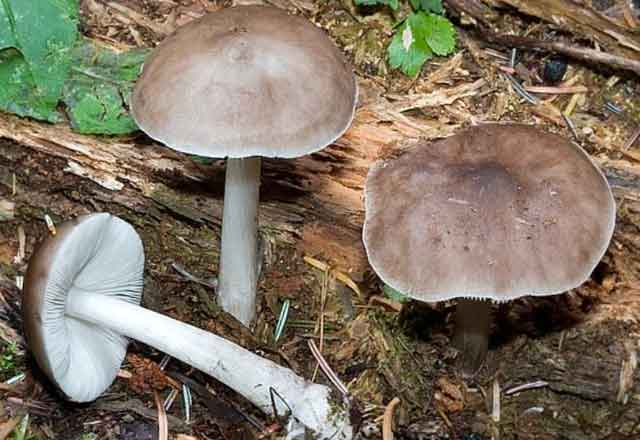


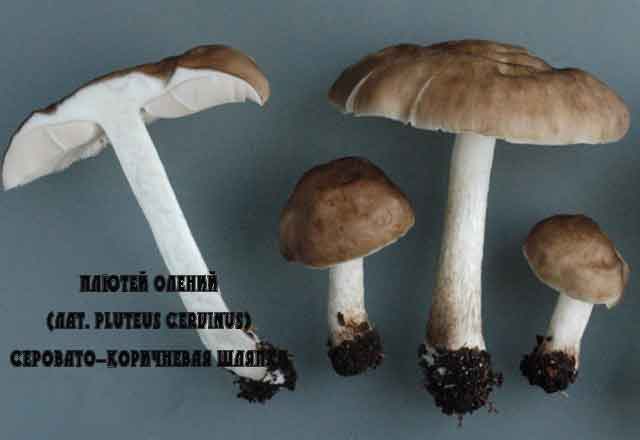
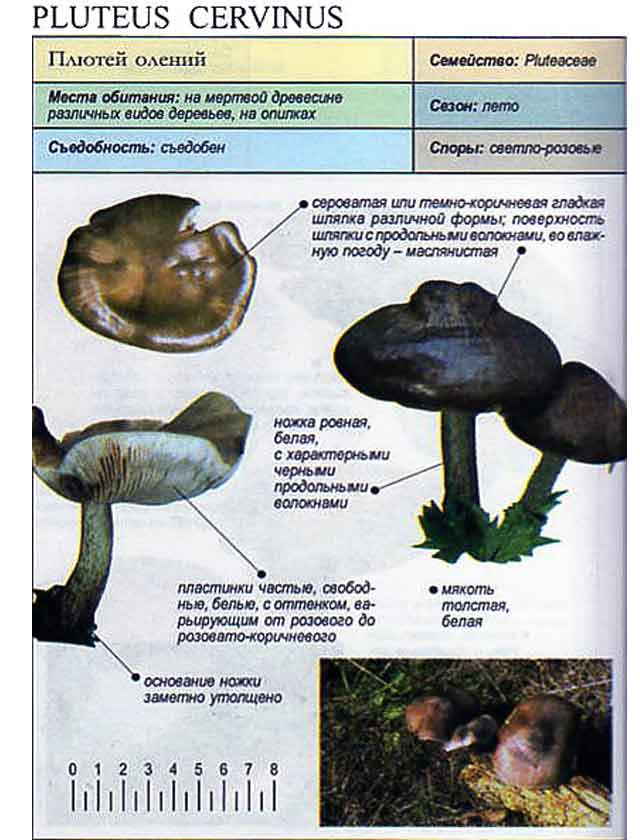
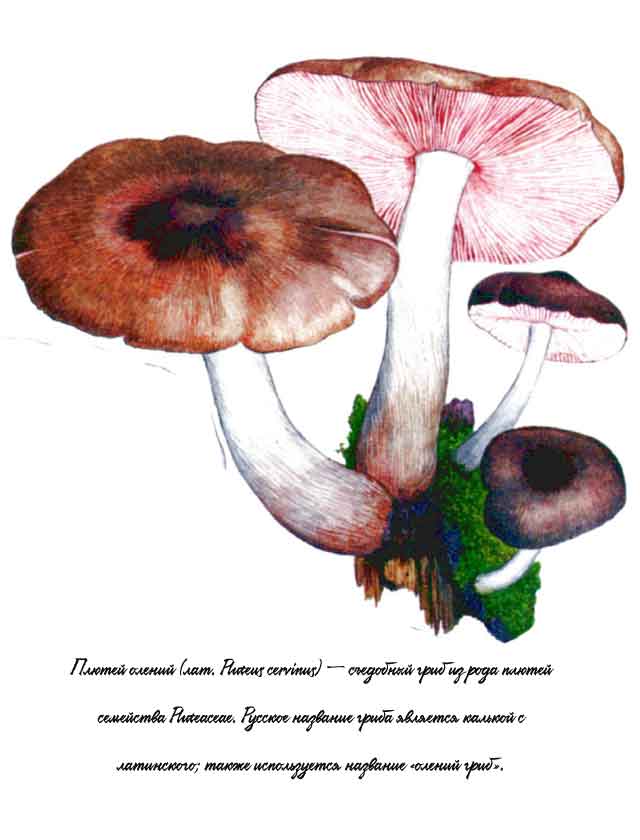
Primary processing
Many mushrooms, including mushrooms, are recommended to be thoroughly washed. To do this, the fruit bodies are briefly placed in cold water, preferably with salt (it will help get rid of small insects and parasites). After that, it is advisable to clean off the top coarse layer of the leg. In older specimens, it is recommended to remove the darkened plates located under the cap.
The mushroom does not require soaking for a long time, moreover, some people find it attractive to eat it raw.
However, such experiments should be handled with caution, as roasting can lead to problems with the digestive tract (or aggravate them). Do not forget about the possibility of latent allergic reactions.
It is contraindicated for nursing mothers and children under 12 years of age.
Description
Deer roach (Pluteus cervinus) belongs to the Pluteaceae family, the Plutey genus, and also has other names, including the deer mushroom, dark-haired roach. In Russia, it is often called a dark fibrous spit or brown spit. By the way, one of the variants of the origin of the name "deer" is a special color of this representative of the mushroom kingdom, which resembles the color of the wool of a noble animal.

Reindeer roach is an edible lamellar mushroom, but some sources claim that it should not be eaten. However, without explaining the reasons.
Interestingly, the deer mushroom has several variations in appearance.
- the cap is rather large, from 4 to 15 cm in diameter (but there are specimens up to 24 cm), it can have a different shape. It is simply convex (broadly bell-shaped), convex with a tubercle in the middle, and also prostrate. The skin is smooth to the touch, becomes slimy in the rain. Surface with longitudinal fibers, felt in the center. The color changes from gray-brown to dark chocolate; during a drought, the cap can fade. It is darker in the middle than at the edges;
- the leg is moderately thin, up to 15 cm long, up to 2 cm in diameter, has the shape of a cylinder. Dense, thickens at the base, easily breaks off the cap. Sometimes it is very curved (it depends on where the stick grows). The color is white, grayish, on a light background there are dark fibers, sometimes a mesh pattern is clearly visible;
- the flesh is white, does not change color at the break, thick, tough, but brittle. The fibers are clearly visible in the stem. Has a rancid odor. There is no taste as such;
- the plates are loose, thick, wide, fairly frequent, white-pink in young spitters, pinkish-brown in old ones;
- spores are smooth, pink, ellipsoidal.
Similar types and differences from them
Almost all spitters are very similar to each other, therefore there are quite a few species similar to deer spit:
- black-edged or dark-edged pluteus (Pluteus atromarginatus) is less common than deer. The main difference is the dark surface of the cap and dark plates;
- mushrooms of the genus Entoloma have adherent plates - this is their main difference;
- volvariella (genus Volvariella) have a volva and thus differ from the deer mushroom;
- Pouzar's plute (Pluteus pouzarianus) is odorless and grows only on soft tree species. If you look at it under a microscope, you can see special buckles on the hyphae, which the deer does not have. The possibility of eating this mushroom is not fully understood;
- wide-lamellar colibia (Megacollybia platyphylla) is not edible, has rare cream-colored plates, and dense mycelial strands can be found at the base of the leg.
In general, in order to distinguish the hero of the article from other mushrooms, it is enough to look at the special color of the plates and its place of growth.
Fortunately, you can only confuse deer whites with other spits, and almost all of the listed species are edible, and there is no risk of poisoning. And besides, it grows even in the driest weather, which means that you will not leave the forest where this representative of the mushroom kingdom lives with an empty basket. His taste, of course, is not the best, but "for fishlessness and cancer - a fish."
Characteristics of the mushroom plyutei
Hat
- Advertising -

The cap of the mushroom is bell-shaped or prostrate, with a tubercle in the center, easily detached from the stem. The size of the cap varies from 1 cm in the smallest species to 20 cm in the large ones. The maximum cap diameter of 24 cm was recorded for the deer spit. The surface is smooth, fibrous, silky or scaly, dry, sometimes slimy or wrinkled, with mesh veins. The color of the cap is also different: from white to almost black, most often brownish-brown, or bright, yellow or orange. The edge is solid or ribbed.
Pulp
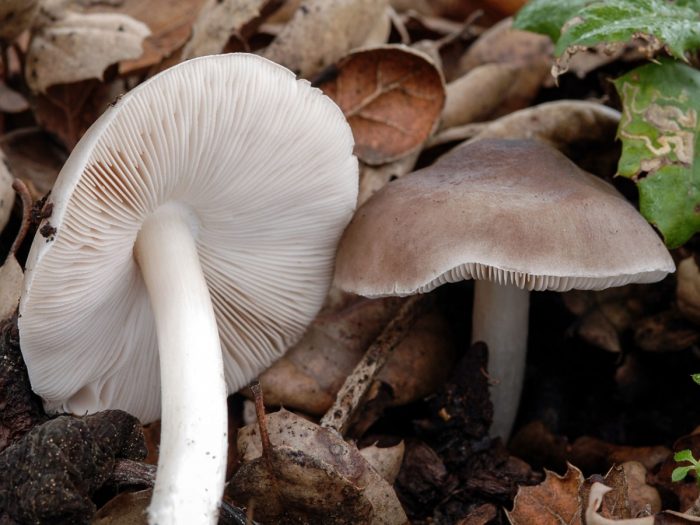
The pulp is light, fleshy, white, grayish or yellowish in color. On the cut, the color does not change, in some species a greenish or bluish tint appears, which is a sign of the presence of psilocybin in their pulp. Smell and taste are poorly expressed. In some species, the pulp is bitter.
Leg
- Advertising -
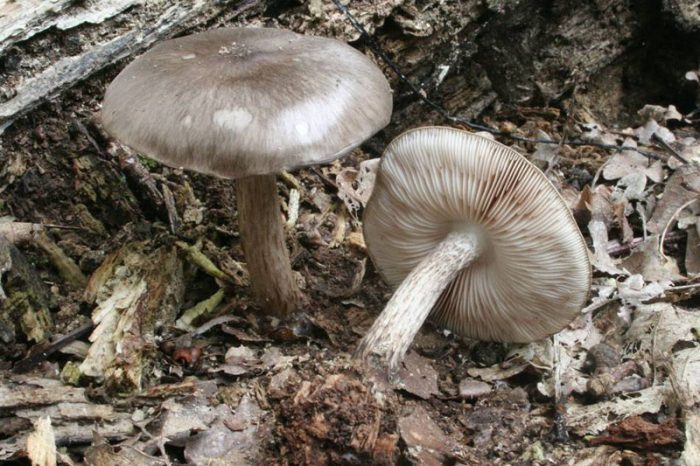
The leg is cylindrical, expands to the base or tuberously swells, fleshy, brittle, solid, sometimes hollow. The surface is naked, fibrous or covered with scales, the base is pubescent.
Edibility and hallucinogenicity of blue-footed spit
It is believed that after pre-boiling, blue-footed plutes are edible. When boiled in water at a temperature of 150 degrees, psilocybin turns into psilocin, and if boiling for a long time, then these toxic components are destroyed and the mushrooms become edible. And upon drying, about 50% of the activity of the psilocybin components remains.

These mushrooms contain psilocin, psilocybin and beocystin. They are considered moderately or weakly active. The concentration of psychoactive substances varies greatly depending on the place of growth. According to research, the bluefoot plutney contains 0-0.02% psilocin, 0.05-0.25% psilocybin and 0-0.008% beocystin.
Physical dependence after the use of blue-legged spit does not develop, but with their regular use, mental craving arises. The action of these mushrooms causes a hallucinogenic effect, a person hears sounds in the head, sees visions, loses the sense of time. It may seem to him that he is watching his body from the side. Eating psilocybin mushrooms can lead to feelings of euphoria and unbridled joy, but large doses can cause feelings of panic and dangerous behavior.
According to research conducted in the UK, psilocybin mushrooms are considered the least dangerous recreational drug. Some studies have noted the "striking non-toxicity" of psilocybin. But in any case, it is a drug, the use of which causes inappropriate behavior, possibly dangerous behavior and health problems.

Similar species
Another psychoactive willow mushroom is close to the blue-legged spitting. But the blue-footed rogue can be distinguished by its smaller size, the wrinkled center of the cap, the uniform color of the plates and the inexpressive taste and smell.
The fruit bodies of willow spitters also contain psilocybin. The diameter of the cap reaches 7 centimeters, the shape of the cap changes over time from bell-shaped to flat-spread. The cap is thick-fleshed, while the edges are thin. The surface is fibrous-wrinkled, shiny. The color is grayish or ash-gray with a bluish or pink-brown tinge. The leg height is 12 centimeters. The color of the leg is bluish with a gray-olive tint.
Willow spits grow on willow, beech, poplar, alder and oak wood. These mushrooms are common in Eurasia, North America and North Africa. They are rare. Listed in the Red Book of the Leningrad Region.

Golden-veined rogue
Description
Ecology: saprophyte on the remains of deciduous or, less commonly, conifers. Causes white rot. Grows singly or in small groups on stumps, fallen trees, sometimes on rotting wood shallowly submerged in the soil.
Hat: 1-2.5 centimeters in diameter. In youth it is broadly conical; with age it becomes broadly convex to flat, sometimes with a central tubercle. Wet, shiny, smooth. Young specimens look a little wrinkled, especially in the center of the cap; these wrinkles are somewhat reminiscent of a venous pattern. With age, wrinkles are smoothed out. The edge of the cap may be finely ribbed. The color of the cap is bright yellow, golden yellow in youth, dims with age, acquiring brownish-yellow tones, but does not completely go brownish, there is always a yellow tint. The edge of the cap looks darker, brownish due to the very thin, almost translucent flesh at the edge of the cap.
Plates: loose, frequent, with plates (rudimentary plates).In youth, for a very short time - white, whitish, when ripe, the spores acquire a pinkish color characteristic of all spitters.
Leg: 2-5 centimeters long. 1-3 millimeters thick. Smooth, fragile, smooth. Whitish, pale yellow, with white cotton wool of the basal mycelium at the base.
Ring: missing.
Flesh: very thin, soft, fragile, slightly yellowish.
Smell: faintly discernible, when rubbing the pulp a little like the smell of bleach. Taste: no particular taste.
Spore Powder: Pink. Spores: 5-7 x 4.5-6 microns, smooth, flowing.
Season and distribution
It grows from late spring to early autumn. Found in Europe, Asia, North America. It is possible that Plyutey golden-veined is widespread throughout the globe, but it is so rare that there is no exact distribution map yet.
Edibility
No data on toxicity. P. chrysophlebius is probably edible, like the rest of the Pluteev genus. But its rarity, small size and very small amount of pulp does not dispose of culinary experiments. We also recall that the pulp may have a weak, but rather unappetizing smell of bleach.
Similar species:
- Pluteus chrysophaeus is slightly larger with brownish tints.
- Lion-yellow roach (Pluteus leoninus) - a roach with a bright yellow hat. Differs in much larger sizes. The hat is velvety, there is also a pattern in the center of the hat, but it looks more like a mesh than a pattern of veins, and in the lion-yellow spit, the pattern is preserved in adult specimens.
- Pluteus fenzlii is very rare. Its hat is bright, it is the yellowest of all yellow spitters. Easily distinguished by the presence of a ring or annular zone on the stem.
- Orange-wrinkled roach (Pluteus aurantiorugosus) is also a very rare roach. Differs in the presence of orange shades, especially in the center of the cap. There is a rudimentary ring on the stem.
Notes (edit)
There was some taxonomic confusion with Plyute golden-veined, as well as with Golden Spit (Pluteus chrysophaeus). North American mycologists used the name P. chrysophlebius, European and Eurasian ones - P. chrysophaeus. Research carried out in 2010-2011 confirmed that P. chrysophaeus (Plyutey golden-colored) is a separate species with a darker, more brown cap color.
With synonyms, the situation is also ambiguous. The North American tradition called Pluteus admirabilis synonymous with Pluteus chrysophaeus. Recent research confirms that Pluteus admirabilis, named in New York in the late 19th century, is actually the same species as Pluteus chrysophlebius, named in South Carolina in 1859. Justo's research recommends dropping the name "chrysophaeus" altogether, as the original 18th century illustration of the species shows a mushroom with a brown rather than a yellow cap. However, Michael Kuo writes about finding (very rarely) populations of Pluteus chrysophlebius with brown caps and yellow caps growing together, photo:

and thus the question of "chrysophaeus" for North American mycologists is still open and requires further study.

